 |
||
|
||
| ||
 Fall... ATI... R-200... oh, sorry, Radeon 8500... which is still hiding somewhere... In Chinese boxes? - We'll get it out!.. Beautiful names from China... This is ATI trying to hide from its competitors... Lower frequencies? - Let's overclock!.. Fail? - It's BIOSes and ATI programmers to be blamed... Bugs... it's drivers... It's a bog... Ahead there is only SmoothVision, it will help us... Oh, just not the Quality way... What's with my Giants?... Tired... Late fall... NVIDIA... A flow of Titaniums... Not Titanics... Geforces and only Geforces everywhere... MX... But I don't want it anymore... Pro or Ultra... But Ultra is too expensive... Wow! Geforce 3! My dream!.. No money? Let's tear to pieces then... Where is the renowned performance? - Anisotropy, get back!.. Something wrong with a trilinear filtering... Radeons are cheaper but their ugly bugs!... However, they are "dual-head"... Do you need it on a game accelerator? - Let it be here... Truform... What's more important? Invisible truform and ghosty pixel shaders of the v1.4, or lack of bugs in games?.. I don't know... Radeon 8500 is also tasty... Though that WinXP... added pepper, shit!.. Titans are still cheaper, though they lack for shaders... But chips are from Ultra, memory is from Pro, and it is cheaper than the latter. Plus different add-ins... VIVO on the Phillips chip. Jerks? - There is new software... Or you can buy a new one... For the sake of WinCoder... What's this? - Find out later... What's extraordinary in the... Nothing!.. Do you remember Geforce2? - It's the same, just the speed is higher and the design is cooler... Red ones are beautiful, though the case is not transparent... And ventilation? - Forced... But where are golden cards? - They will be, though the today's Golden Sample doesn't mean a gold textolite. Here we come to the Gates of the Gainward Kingdom where golden samples hide. We have already found keys to many, and today we will take a look at a red and speedy (4ns!) one. Here it is - Gainward GeForce2 Ti/500 XP! CardThe Gainward GeForce2 Ti/500 XP card has an AGP x2/x4 interface, 64 MBytes DDR SDRAM located in 8 chips on the right side of the PCB. 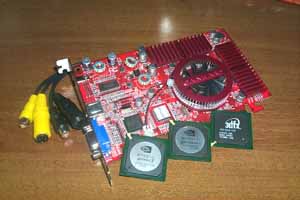 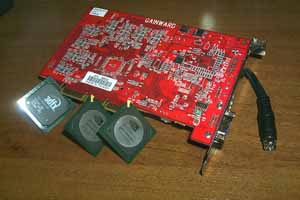 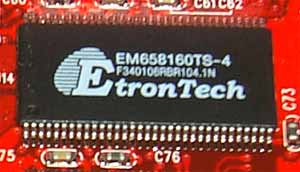 EtronTech produces memory chips with 4 ns access time, which corresponds to 250(500) MHz. As you know, all Ti 200 based cards have the memory working at 200 (400) MHz that is why 5 ns modules are sufficient. However, such cards are usually equipped with the memory which is available in stock or with a faster memory. 500 means one of the rated frequencies. The Golden Sample cards have two modes: standard (frequencies recommended by NVIDIA) and extreme (thanks to carefully selected chips and a faster memory). The extreme mode can be set with the ExperTool utility which was described earlier. The card in question also has two modes: a standard one - 250/200 (400) MHz and an extreme one - 270/250 (500) MHz. Gainward guarantees that the card can work stably at these frequencies. When we examined new cards from Inno3D we saw that the Inno3D GeForce2 Ti is based on the NVIDIA's design for GeForce2 Pro cards. Let's check whether the Gainward GeForce2 Ti/500 XP follows the same reference design from NVIDIA for the GeForce2 Pro: Gainward GeForce2 Ti/500 XP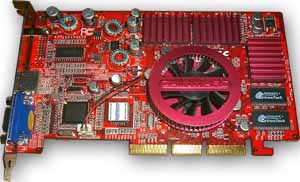  Chaintech AGP-RI93 (NVIDIA GeForce2 Pro reference card)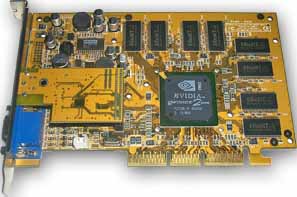 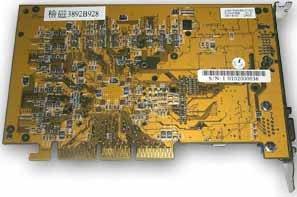 There are differences. Unfortunately, we can't compare our card with the reference one on the GeForce2 Ti, though there were some photos on the Net and they differed from the Gainward's card (the reference sample has SGRAM modules instead of SDRAM). Nevertheless, its earlier and also fast GeForce2 Pro based card followed the GeForce2 Ultra design (Gainward GeForce2 Pro/450). However, it turned out that the design was far imperfect and an image was bad. Besides, all Ultras overheat much. If you overclock the memory up to the frequencies of the GeForce2 Ultra - 230 (460) MHz, the Gainward GeForce2 Ti/500 XP will be much cooler. Moreover, this card has a VIVO onboard, that is why the design is anyway unique. The cooler is rather huge: 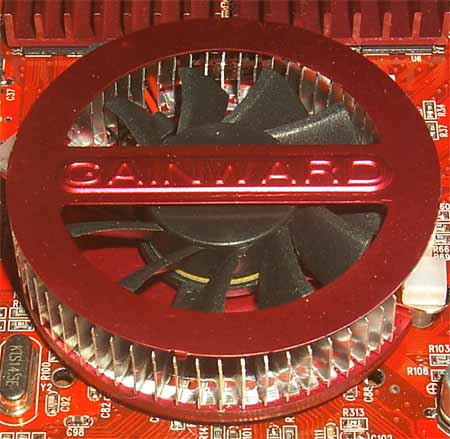 This model is efficient enough, and we managed to overclock the chip to 300 MHz and beyond without much effort to install additional cooling. The cooler is fixed with pins. If you take off the heatsink you will see the GPU: 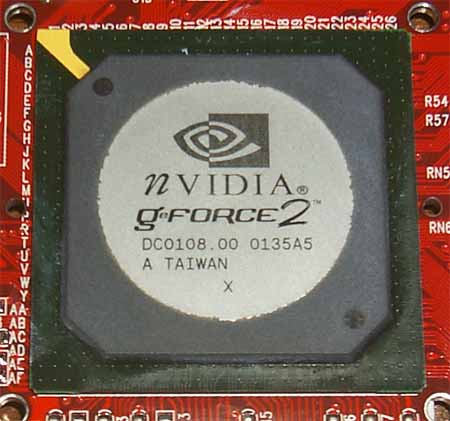 The chip looks very similar to the GeForce2 Ultra due to a metallic cover in the center. Well, in fact, it is the same processor whose technology was tweaked and now the percentage of non-defective chips is much higher and, therefore, the production costs are lower. The card is accompanied with VIVO. Unfortunately, for the Video In on the Philips 7100 there are not much software which can correctly identify WDM Capture drivers from NVIDIA used to activate this function. Till recently such cards came with the Ulead VideoStudio program which often displayed a black-and-white image in a video capture mode, and the copy protection (MacroVision) often took amateur sources as licensed ones. Today some companies use a WinCoder packet with VIVO cards (I will describe it in the review of Titanium series from ASUSTeK). Unfortunately, Gainward supplies its cards with the old ULead VideoStudio.  The card ships in a Retail package. Accessories:
OverclockingThe Gainward GeForce2 Ti/500 XP excellently overclocks as it reached 310/260(520) MHz. It demonstrates the level of the Leadtek GeForce2 Ultra. That is why we can expect a considerable performance gain. Note:
Test system and driversTestbed for the Gainward GeForce2 Ti/500 XP:
During the tests we used NVIDIA drivers of v21.85, VSync was off, the S3TC technology was enabled. For the comparative analyses we used the following cards:
Test results2D quality is excellent, at least in 1600x1200 at 85 Hz. However, my estimate is subjective and depends on a certain card and on whether a monitor and a card get on. Noteworthy is the fact that to estimate 2D graphics you should have a high-quality monitor, and if the latter has BNC connectors you should use them. For estimation of 3D quality we used:
Quake3 Arenademo002, standard modesThe tests with the demo002 were carried out in the High Quality mode (32-bit color).  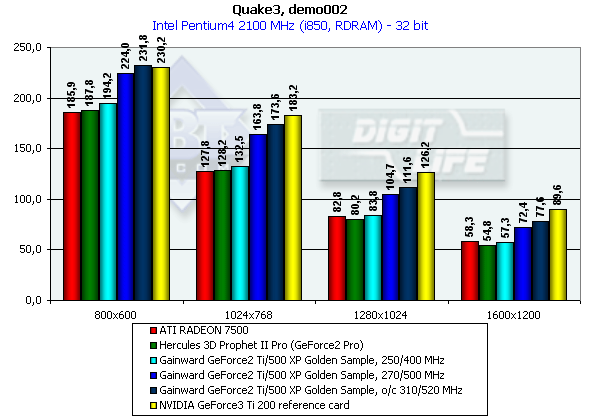 Quaver, High Quality ModesThe tests were carried out in 32-bit color mode at the highest detailing level and with complicated geometry (r_subdivisions "1" r_lodCurveError "30000"). This benchmark loads an accelerator with geometry, large textures and huge effects. 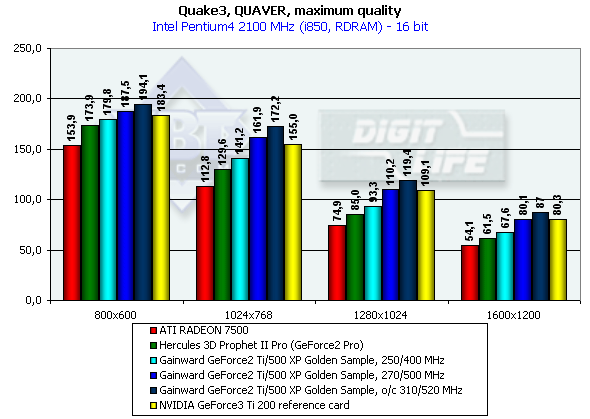  Both tests are meant to demonstrate whether the card corresponds to its level. Keep in mind that even the maximum overclocking didn't allowed the Gainward GeForce2 Ti/500 XP to catch up with the slowest competitor from the GeForce3 family (in 32-bit color). Just compare 310 and 175 MHz! The today's card goes on a par with the ATI RADEON 7500 (produced by ATI as cards from its partners are slower) in 32-bit color, but in 16-bit color the Canadian card lags behind. The extreme mode helps the Gainward GeForce2 Ti/500 XP easily outscore the RADEON 7500 one. It is a real problem to choose between them as the prices are equal. The RADEON 7500 card has a dual-monitor support and a TV-out. The GeForce2 Ti card lacks for the former, while the TV-out is of lower quality. But it comes with VIVO. If you don't have this problem of choice, the Gainward GeForce2 Ti/500 XP can be considered the best sample in its class. In closing, I'd like to advise you to read also other reviews of GeForce2 Pro/Ti based video cards. Besides, in our 3Digest you can get thorough information on performance of these cards on different platforms. ConclusionThe Gainward GeForce2 Ti/500 XP is the brightest model of the GeForce2 family with its excellent speed characteristics, fine quality and a VIVO (look for the WinCoder program ;-)
The complete characteristics of video cards of this and other classes can be found in our 3Digest. Highs:
Lows:
Write a comment below. No registration needed!
|
Platform · Video · Multimedia · Mobile · Other || About us & Privacy policy · Twitter · Facebook Copyright © Byrds Research & Publishing, Ltd., 1997–2011. All rights reserved. |